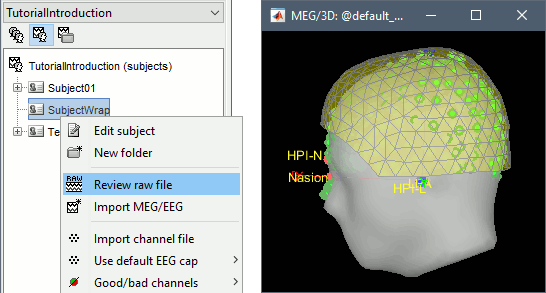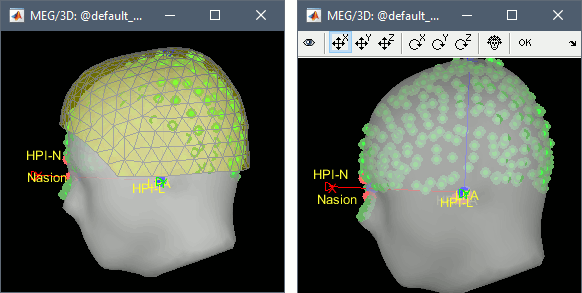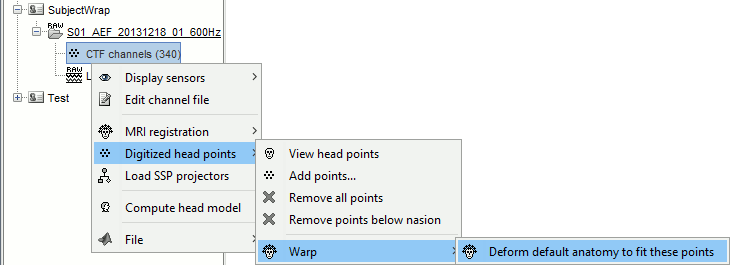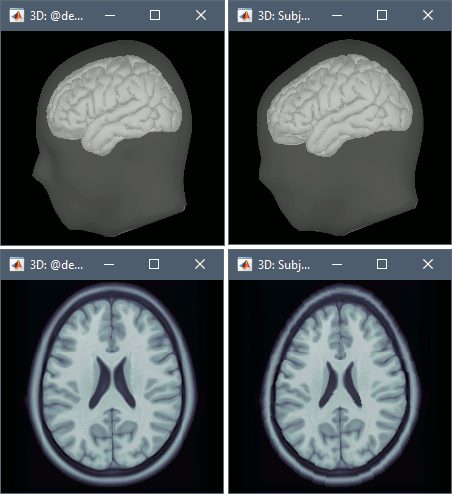|
Size: 2054
Comment:
|
Size: 2730
Comment:
|
| Deletions are marked like this. | Additions are marked like this. |
| Line 6: | Line 6: |
| === Prepare the subject === We are going to test that feature in the protocol ''TutorialNeuromag'', created in the tutorial [[Tutorials/TutMindNeuromag|Import and process Neuromag raw recordings]], because it contains a reasonable amount of head points, and it should be already in your database. |
== Prepare the subject == We are going to test that feature in the protocol ''!TutorialNeuromag'', created in the tutorial [[Tutorials/TutMindNeuromag|Import and process Neuromag raw recordings]], because it contains a reasonable amount of head points, and it should be already in your database. |
| Line 9: | Line 9: |
| 1. Select protocol ''TutorialNeuromag'', and select the view "Functional data (sorted by subjects)"'' '' 1. Create a new subject "!SubjectWarp". Select the option "Yes, use default anatomy" |
1. Select protocol ''!TutorialNeuromag'', and select the view "Functional data (sorted by subjects)" 1. Create a new subject "!SubjectWarp". Select the option "'''Yes, use default anatomy'''" |
| Line 14: | Line 13: |
| . {{attachment:treeBefore.gif}} | 1. {{attachment:treeBefore.gif}} |
| Line 16: | Line 15: |
| === Check the MRI/MEG registration === This process is very sensitive to the initial position of the head points relatively to the scalp surface. |
== Check MRI/MEG registration == This process is very sensitive to the initial position of the head points relatively to the scalp surface. You really want to make sure that the alignment is correct before running the deformation of the default anatomy. Right-click on channel file > '''MRI registration > Check'''. |
| Line 19: | Line 18: |
| Use the digitized head points to create a pseudo-individual anatomy, in the case you don't have an individual MRI for the subject. It uses the default anatomy (MNI/Colin27) and deforms it to match the head points. Make sure the alignment is correct before calling this menu. | It can be better. Get more accurate registration: right-click on channel file > '''MRI registration > Refine using head points'''. The two following figures represent the registration before and after. . {{attachment:refineBefore.gif}} {{attachment:refineAfter.gif}} == Warping anatomy == Right-click on the channel file > Head points > Warp > Deform default anatomy to fit these points. . {{attachment:warpPopup.gif}} Go in the Anatomy view of the protocol (first button on top of the database explorer). All the files from the default anatomy MNI/Colin27, MRI and surfaces, have been deformed to fit the head points from the channel file of !SubjectWarp. The following figures represent the anatomy before (left) and after (right). . {{attachment:warpDone.gif}} |
Warping default anatomy
The best results for source localization are obtained with an individual anatomy of each subject, that are processed to extract the cortex and the scalp surface. Unfortunately, scanning a subject in an MRI costs in time and money, and may not be available for the source analysis. In this case, it was already explained in the previous tutorials that you can use the default anatomy MNI/Colin27. But for subjects that have head shapes that are really different from Colin Holme's, the localization errors can be really big.
For this purpose, Brainstorms offers an intermediate solution: Creating a pseudo-individual anatomy based on the head points that were digitized with a magnetic tracking system before the MEG acquisition. Those points really represent the shape of the head of the subject, they can be used to scale and deform the Colin27 MRI and surfaces.
Prepare the subject
We are going to test that feature in the protocol TutorialNeuromag, created in the tutorial Import and process Neuromag raw recordings, because it contains a reasonable amount of head points, and it should be already in your database.
Select protocol TutorialNeuromag, and select the view "Functional data (sorted by subjects)"
Create a new subject "SubjectWarp". Select the option "Yes, use default anatomy"
Copy the channel file from Subject01/(Common files) to !SubjectWarp/(Common files): Use either the keyboard shortcuts Ctrl+C and Ctrl+V, or the popup menus File > Copy/Paste.

Check MRI/MEG registration
This process is very sensitive to the initial position of the head points relatively to the scalp surface. You really want to make sure that the alignment is correct before running the deformation of the default anatomy. Right-click on channel file > MRI registration > Check.
It can be better. Get more accurate registration: right-click on channel file > MRI registration > Refine using head points. The two following figures represent the registration before and after.
Warping anatomy
Right-click on the channel file > Head points > Warp > Deform default anatomy to fit these points.
Go in the Anatomy view of the protocol (first button on top of the database explorer). All the files from the default anatomy MNI/Colin27, MRI and surfaces, have been deformed to fit the head points from the channel file of SubjectWarp. The following figures represent the anatomy before (left) and after (right).



